Taking the Lead(ers)
By the way, that was the end of my first session playing Epic 27. I began the Epic at around 11 PM on a Friday night, and it's now eight hours later. I did not leave my chair that entire time.
I don't think I've shared this before, but starting an Epic game is a bit of a special event for me. I wait, a week or two if necessary, until I have a night that I can completely devote to the game. I'm totally focused on the game during that time, keeping every detail of every city in my head, making best, perfect use of city micromanagement, workers, and units. Usually, I try to have that first session last until the governmental change, to get through the anarchy while I'm still in that state of total concentration. Once you move into the midgame, the importance of every little detail diminishes, and I can afford to take a more leisurely approach to the game. But those first few hours are a special experience, and what keeps me coming back to Civ 3 so many times.
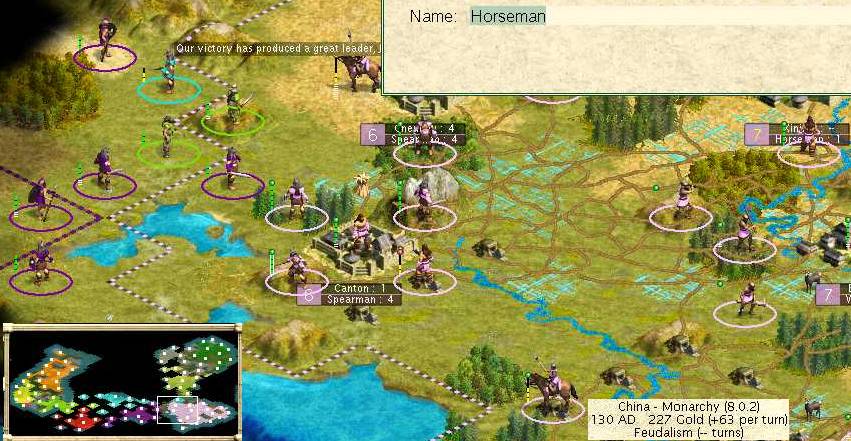
Well, the Leaders do keep coming. Shanghai doesn't have a wonder to build immediately; it's busy with its library and colosseum. And so I need a Forbidden Palace somewhere, and I need it soon. For all Shanghai's great aspirations, it just isn't a good geographical site for the FP. Macao is better both in the short term, and in the long run for when I move the Palace away from Beijing.
That picture shows a better illustration of the "what can wait should wait" principle applied to invaders. Note how I've killed any enemy unit within one square of my cities, so that none of them will get to attack me. Any swordsman stack more than one square away can safely wait, and would never get priority over something that could attack me in one turn.
Feudalism comes in from the Great Library in 230 AD, and I start upgrading to pikemen and medieval infantry. It'll be a while before the AIs get pikemen my way, and even when they do there'll be many more MDI than pikes. Since superior tactical maneuvering gets me the first attack nine times out of ten, I'm very happy warring with 4.2.1 units on each side rather than 3.2.1. The casualty count has already been around 3-to-1 in my favor, and these MDI would ratchet it up to close to five to one.
I didn't get a picture of Leader Five, in 260 AD. He rushes Sun Tzu's Art of War in glorious Shanghai, which had just finished building its library and colosseum. Persia makes a backwards cascade from Sun Tzu's to the Great Lighthouse, heh.
And it has been a while since I got surprised by this, but Sun Tzu's surprises me by triggering the Golden Age!! I guess it's a good thing that I didn't get the Great Wall - it fell to Babylon in cascade from the Hanging Gardens and Great Library.
Well, back in the Ancient Age, I was able to hold out against several rivals in Golden Age without being in such myself. And now I've gotten my own Golden Age going while theirs have expired, so I should darn well be able to get in the lead and stay there.

Leader Six arrives in 290 AD. Shanghai swaps its cathedral-under-construction to a courthouse, rushes it, swaps to a marketplace to complete it this turn, then next turn the Leader rushes Shanghai's cathedral.
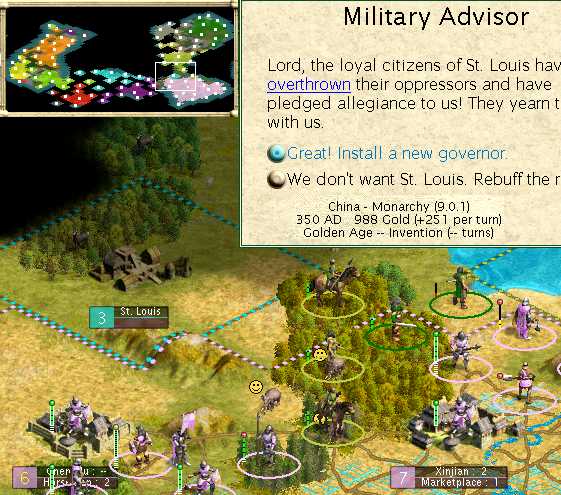
Then I get my first cultural flip. Heh, in Always War, I acquired my first enemy city not by war, but by culture. My culture is ridiculously high, on the order of three times anyone else's and up to ten times as high as the laggards like the Iroquois. Shanghai of course is about three-fourths of that total all by itself.

Of course, St. Louis was immediately recaptured by incoming enemy units that were already surrounding the city. Oh well.
Also that turn, I make my first action against an enemy city.

I decided to keep it rather than build a settler to replace it; I did starve it down to size 1 to greatly reduce "Stop the aggression" Mongol unhappiness.

Leader Seven comes in 420 AD. Shanghai has been building Sistine Chapel from scratch, and has only ten turns to go (thanks to the Golden Age production), so I use him for an army to save until filling it with Riders.
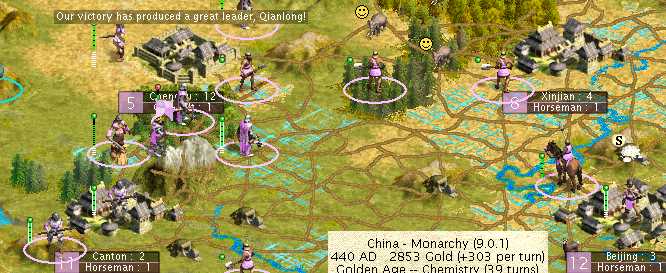

Leader Eight shows up only two turns later, and does the same thing.
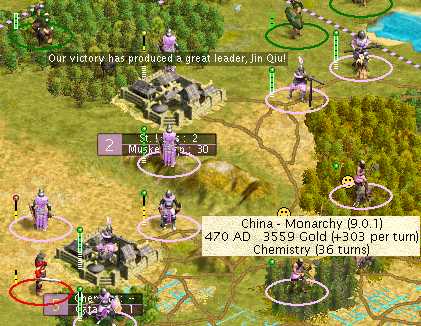
Then Leader Nine arrives, and there's an important difference in my situation since the last leader: Chivalry came in from the Great Library. Given that, I decide to save this Leader to rush a wonder in Shanghai after it completes its current wonder, and use veteran Riders in combat in the meantime to get some of them up to elite.
Here's a current shot of the Ming Kingdom.
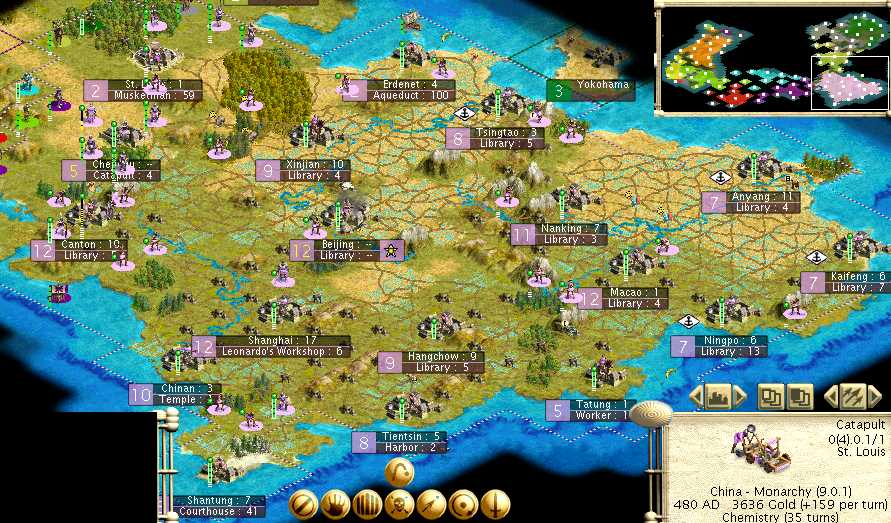
Macao is the Forbidden Palace site. I also discovered something interesting about Canton: if I parked a unit - even a spearman - on the hill to its southwest, no AI units would ever attempt to attack it. That blocked the land path to Canton between the lake and the ocean. The AI units would never move into the square adjacent to the hill; they'd always go the other way round the lake. That simplified my tactical maneuvering somewhat.
Tatung is one of my patented worker factories, easily able to hit the +10 food threshold. In Golden Age, it was producing a worker every turn. Once out of Golden Age, though, the city actually turned out to be incapable of producing 10 shields and so couldn't make better than a worker every other turn. But with that initial flood of workers, our Industriousness, and a steady flow of slave workers as well, this was quite sufficient. Cities like Anyang got workers merged in to reach size 12 rather than waiting for extremely slow ten-turn growth.
And I did recapture St. Louis on my own, and as you can see I built walls there. That gave me a better arrangement of the front; instead of that forest area by Xinjian and the strip of land towards Erdenet, I can intercept enemy units in one place at St. Louis.
You can also see I'm building Libraries, for the Great Library is due to expire soon.
So, in 530 and 540 AD, for the third time this game, Shanghai completes a hand-built wonder and a Leader-rushed wonder on consecutive turns. I did Leonardo's first, because the timing on the northern front was such that I wanted to pre-turn-upgrade a bunch of horsemen on the same turn. Then Sistine completes on the next turn.

In 540 AD, I get a most unusual message:

Chemistry from the Great Library! Excellent! Now, researching is supposed to be folly at first-civ prices, especially in Always War, and especially especially when you have the Great Library! But with the GL having put me two techs away from Military Tradition, there's no way I'm going to let this opportunity pass by. I can get cavalry with all the other civs probably at least sixty turns away from riflemen. (Education has been available to research for thirty turns; nobody is going to get Metallurgy for me before that happens.) I slam the slider to maximum research on Metallurgy; that 2600 gold in the treasury would sustain maximum deficit research for basically the rest of the Middle Ages.
Education then does arrive in 580 AD, and I scroll-ahead to Shanghai and rush the university. Yet another Leader pops in 610 AD, and he rushes The Pentagon in Shanghai.
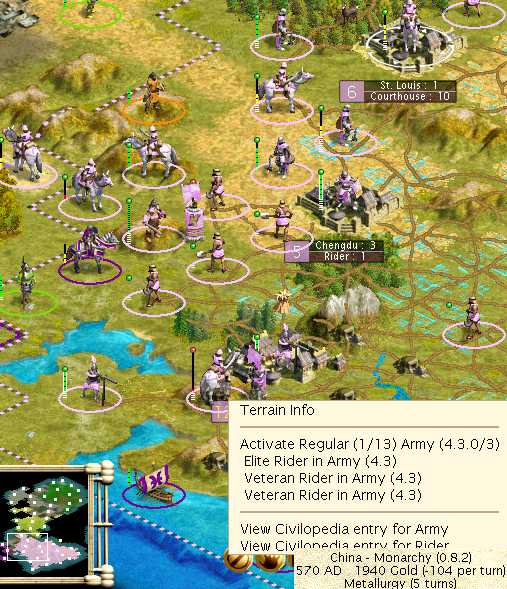
See, running armies without the Pentagon and that fourth unit can be dangerous. That army was at full 13-HP health before attacking a simple musketman, and dang near died!
Well, now with that big boost in Golden Age production, and with the Riders riding at full speed, I can take the war to my opponents.
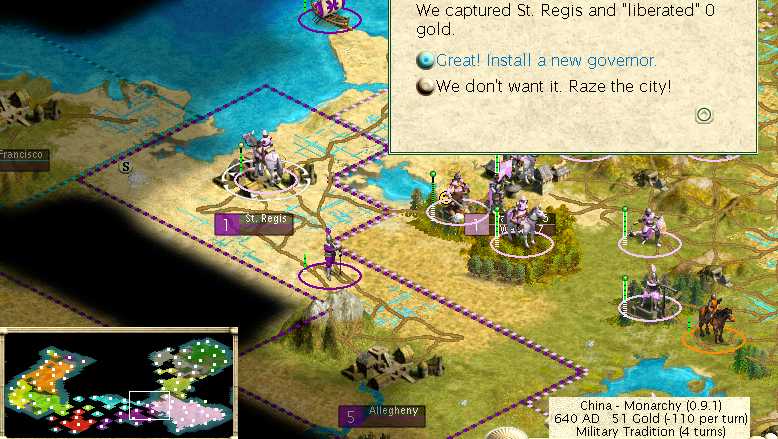
And now, I've got the opponents divided into two distinct fronts. In this picture, you can see the progress I've made on the western front. My city was founded there to claim the Spices (they're under my big stack). I only had two luxuries up to now; the silks and ivory; this third one lets luxury tax finally drop to 10% from 20%.
The Riders' speed is invaluable as always: look at the tactical situation here. My Riders could run out from that heavily-defended square (there's a fortress there too), attack St. Regis, and retreat on the same turn. I razed St. Regis; the point of this was to disconnect the Iroquois saltpeter there. (You can't see the road on the saltpeter in that shot, but moving a rider through neutral territory after St. Regis was razed revealed it.) I might be beelining towards cavalry myself, but the AIs won't take long to get there either, and cavalry are much harder to run tactical maneuvers against than medieval infantry.
Index | Next












